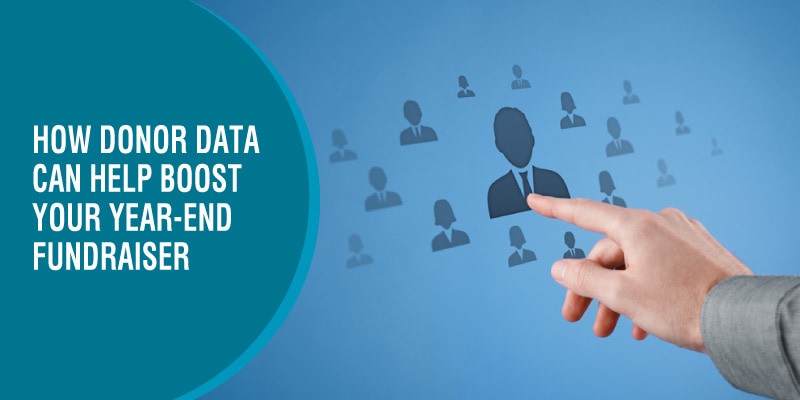
How Donor Data Can Help Boost Your Year-End Fundraiser
As a nonprofit professional, you’re likely aware of how important donor data is for your fundraising strategy. Detailed donor data helps you focus your messaging for separate types of supporters, thereby increasing engagement and retention rates.
Meanwhile, you’re also likely aware of the importance of year-end fundraising. Most organizations see the majority of their fundraising revenue toward the end of the year.
So, how can you use donor data strategies to create the most effective year-end fundraiser for your nonprofit?
To create the best year-end fundraising campaign for your nonprofit, keep these tips in mind:
- Summarize supporter involvement and show appreciation.
- Consider the different demographics that make up your supporter base.
- Leverage supporters’ preferred giving platforms.
- Reach out using preferred methods of communication.
- Use past fundraising campaign data to set realistic goals.
- Don’t forget about other year-end giving campaign best practices.
Building your strategy based on data-driven supporter personas is the first step to boosting fundraising campaigns. Make the most of your year-end fundraisers with this same technique. Let’s get started with tips to do so.

1. Summarize supporter involvement and show appreciation.
The end of the year is a time of reflection for much of the population. Thinking back over the past year, analyzing accomplishments, and making goals for the future is human nature toward the end of one year. As a nonprofit, you can harness this reflective energy early to encourage more engagement from supporters.
Pull data from your organization’s CRM to summarize and communicate each supporters’ involvement and impact on your nonprofit over the last year.
Send this message in the form of an email or a letter to your supporters. Consider including key information such as:
- How much that supporter gave to your nonprofit during the year
- Accomplishments your nonprofit has made as a result of their generosity
- Total hours your supporter volunteered with your nonprofit
Genuinely thank your supporters for the positive impact they’ve made on your nonprofit during the last year. Then, ask them to help you reach your next goal. Include calls to action such as:
- We only need to raise X more to reach our goal of X! Be a part of the movement to support [mission statement]. Donate today!
- It’s your last chance to donate for tax deductions in 2019. Give today!
- You’ve made such an impact during 2019. Help us get a jump start on 2020 by donating today!
Plus, sending the information about the gifts supporters have made to your nonprofit and the impact those gifts have made are key for tax season. Salsa’s fundraising CRM guide explains the importance of reporting donation data back to supporters with automated gift acknowledgments.

2. Consider the different demographics that make up your supporter base.
Make sure you have effectively segmented your donor base before you jump into your year-end fundraising initiative. One segmentation strategy to employ (using the donor data in your CRM) is segmenting your donors by demographic.
For example, knowing the generation of your supporters can provide insight into the type of engagement they’ll prefer during your year-end fundraiser. Generally, the engagement preferences for different generations look like this:
- Generation Z donors were born during or after 1996. Already 30% of this generation has donated to an organization and 26% volunteer. They’re predicted to prefer mobile apps as a donation platform.
- Millennials were born from 1977 to 1995. This generation makes up 11% of total giving to nonprofits and 21.9% of them volunteer. 84% of millennial employees donated to a nonprofit in 2014.
- Generation X consists of those who were born 1965 to 1976. They represent 20% of all giving. Generation X and Millennials together will inherit over $40 trillion. Also, within this generation, volunteers (28.9% of the population) are twice as likely to give to nonprofits.
- Baby Boomers were born from 1946 to 1964. They represent 43% of total giving and 25.7% of them volunteer. They do research before giving, as 49% of Baby Boomers prefer to know about the nonprofit’s finances before they decide to give.
- Matures are the generation born 1945 and earlier. This generation represents 26% of total giving and 24% of them volunteer. 60% of giving from this generation goes towards religious and spiritual causes.
Segmenting your supporters by generation can provide educated guesses as to how each generational segment of donors is likely to behave during your nonprofit campaign, which can inform strategy.
For instance, a nonprofit with a religious mission may market more heavily to the donors who are part of the Mature generation, knowing that 60% of their gifts tend to go toward religious and spiritual causes.

3. Leverage supporters’ preferred giving platforms.
Another method of segmentation is to use the data in your database to inform your nonprofit of donor preferences. This will result in more accurate segments than making assumptions based on generational differences. One of the important metrics to look at is preferred giving platforms.
Consider what platforms your donors tend to use most frequently to give to your organization. If they tend to use one or two more than others, that donor probably prefers that particular platform.
Create segments of donors who have given on different platforms such as:
- Peer-to-peer fundraising pages
- Online donation pages
- Over the phone
- Cash or check
Reach out to donors and promote their preferred method of giving to make the donation process easier during your year-end fundraiser.
If all of these tools are integrated with your CRM, it’s much easier to run reports to see data about the most frequently used platforms and to create the necessary segments.
These tools could be integrated if your CRM provider also offers all of these fundraiser tools. Or, if you’re on a popular non-industry-specific CRM like Salesforce, you may have tools that will integrate with the CRM from the app store. If your tools aren’t yet integrated, look for tools like those in this article to build out your nonprofit toolbox.

4. Reach out using preferred methods of communication.
Just as you segmented your supporters to promote specific donation platforms, you can create segments based on preferred methods of communication. Look for indications about the types of communication your donors have responded positively to in the past, then leverage those tools to reach out to them about your year-end campaign.
Look at metrics like click-through rate, UTM codes, and bounce rates to gather information about donor preferences. Another option is to simply ask them their preferences in a survey.
Craft your nonprofit marketing plan around the results of these reports and surveys. This will show you where to place your emphasis and how to reach out to donors in a smart way. Leverage tools such as:
- Email. Email is especially effective because it allows your nonprofit to send messages directly to the inbox of your supporters. It’s individualized messaging.
- Social media. Posting to Facebook, Instagram, Twitter, Snapchat, etc. is important, but you may also consider sending direct messages to your supporters.
- Direct mail. Snail mail isn’t dead! Especially when paired with your digital strategy, it can be effective when marketing to older generations.
- Face-to-face contact. Schedule meetings with your greatest stakeholders and host events to chit-chat with your mid-tier to lower-level donors to encourage conversation.
Reaching out using the best method of communication is a great way to ensure your supporters see information about your year-end campaign. This is especially effective when you work closely with a marketing agency like Media Cause.

5. Use past fundraising campaign data to set realistic goals.
Pulling past fundraising campaign data can help your nonprofit set realistic, yet ambitious goals for your year-end fundraising campaign.
Every year, you want to improve your metrics and raise more than the year prior. But you also need to create realistic goals based, most often, on past data.
To set your goal, look at information such as:
- How much your nonprofit raised during your year-end fundraising campaign last year.
- How much you’ve raised per different fundraising platform during the last year.
- Who are your major donors and do you have any new prospects with a high propensity to donate?
If you’ve conducted fundraising testing during the last year, make sure you also take your findings into consideration. If you haven’t conducted this testing (and you have enough time to do so before your campaign begins) it could be worth walking through the steps.
Fundraising tests can help you better understand the marketing initiatives that are most effective among your supporters.

6. Don’t forget about other year-end giving campaign best practices.
Having access to the best data from your nonprofit’s CRM is key for strategizing for your nonprofit’s year-end fundraiser. However, don’t get so caught up in the data that you forget about other best practices.
Consider tips from the articles posted by industry professionals like Media Cause or DNL OmniMedia while you’re crafting your strategy.
Some of these best practices include:
- Implement any necessary software updates before the season begins.
- Establish a donor-centric approach to your campaign.
- Craft email templates ahead of time according to donor segments.
- Heavily promote giving days like #GivingTuesday.
- Consider holiday themes and events.
- Give yourself meaningful deadlines.
- Think about the impact of the end of tax season.
By incorporating best practices and strongly considering the most important donor data strategies, your nonprofit will be ready to take on the end of the year!
Donor data is one of the major keys to success during any fundraising campaign. Incorporating smart strategies into your year-end campaign can make a major impact on your nonprofit’s overall fundraising success story.

Gerard Tonti, Salsa Labs Senior Creative Developer
Salsa Labs is the premier fundraising software company for growth-focused nonprofits. Gerard’s marketing focus on content creation, conversion optimization and modern marketing technology helps him coach nonprofit development teams on digital fundraising best practices.